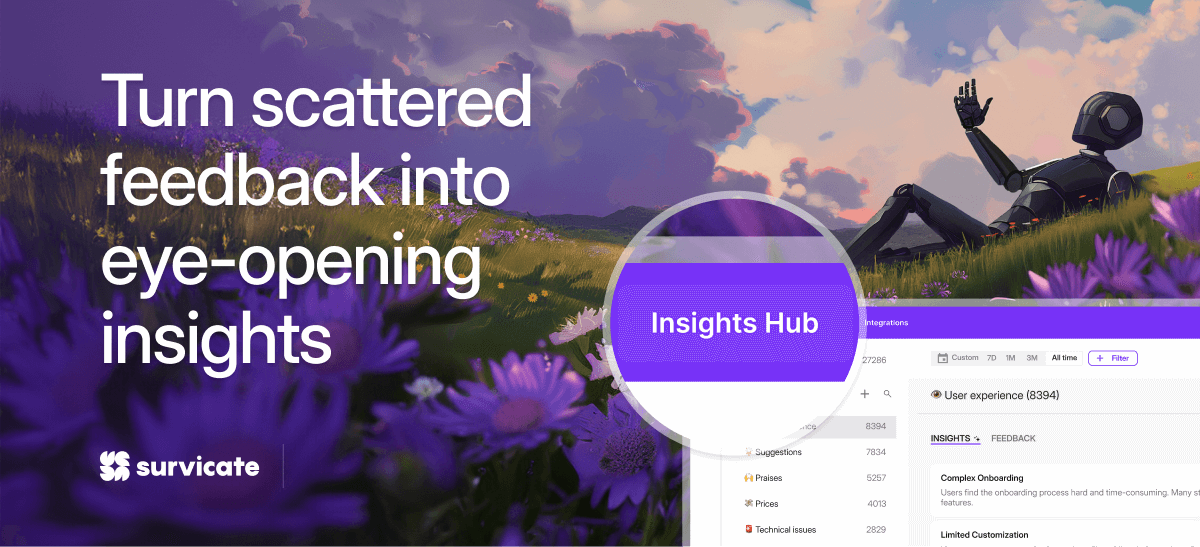2026 won’t bring a CX revolution. There won’t be one breakthrough technology or trend that changes the way we work overnight. No dramatic pivot, no flashy buzzword that flips things upside down.
What’s changing, quietly but unmistakably, is the way teams look at customer touchpoints, internal processes, and the people on both ends of the interaction. We’re rethinking what it means to truly listen, to respond fast, to personalize with intention, and to make every customer feel like the only one that matters.
In this article, we’ve gathered five CX trends not based on hype, but on real signals from industry leaders, analysts, and experienced practitioners. These trends are already unfolding. You just might not have named them yet.
We break each one down to show how the shift is happening, what it means in practice, and what you can start doing next quarter to stay aligned and not fall behind.
Trend #1: AI-powered feedback analysis is becoming the new standard
Honestly, is there any industry left where artificial intelligence isn’t already disrupting the status quo, or poised to do so in the very near future?
CX is no exception. It’s one of the areas where AI is already proving to be a major game-changer.
If there’s one thing large language models excel at, it’s processing and categorizing big volumes of information. But that’s not the real breakthrough. What truly matters is what this enables: the ability to participate more directly in customer needs and preferences across every touchpoint.
“AI-driven personalization will be pivotal in CX. By using data insights, brands can craft individual experiences, turning interactions into seamless journeys,” says Chad McDaniel, CEO of Execs In The Know.
At Survicate, the team’s experience confirms these observations, which is why AI-powered feedback analysis is becoming a central component of the product.
-p-1600.webp)
Imagine this: instead of manually sifting through data, you start asking smart, high-level questions like:
- What issues have been appearing most frequently over the last 90 days?
- Why are users barely engaging with our new feature?
- What do customers really think about our product’s design and how could we improve it?
By analyzing large feedback datasets originating from real human voices, AI surfaces answers to these questions and delivers them in a form that’s digestible and actionable for your human-powered ecosystem.
The time saved through automated feedback analysis, combined with the ability to maintain consistency and discipline in listening to customers, is a massive lever for businesses in 2026 and beyond.
This kind of "research assistant", one that helps you extract actionable insights from the chaos of customer feedback, is becoming a must-have tool for any team that wants to do more than just keep an ear to the ground. It’s about something much more important: giving meaning to the voice of the customer and turning that meaning into action.
How to act on this trend today
- Automate your feedback analysis. Use analytics tools such as Survicate to tag, group, and summarize feedback automatically, so your team focuses on the “why” behind the data.
- Ask smarter questions, less often. Instead of sending long quarterly surveys, use short, contextual questions triggered by key customer actions.
- Bring feedback to where decisions happen. Integrate feedback data with Slack, CRM, or product boards so that all teams see insights in real time.
Trend #2: Trust remains the strongest currency, but the stakes are shifting
Trust has long been one of the most valuable “soft assets” a company can hold. And in the age of global, real-time information sharing, its importance has only intensified.
What’s changing now, and will matter even more in the years ahead, is a new layer of trust: trust in what your company does with customer data. Especially when AI is involved.
Privacy concerns have been around for years. But the arrival of AI, and the growing public awareness around how LLMs are trained on data of often murky origin, has made customers especially alert to how any company handles their information. From the size of their shoes to the number on their credit card.
CX influencer Blake Morgan named this trend bluntly: “Trust is the new currency.” Brands must differentiate themselves by leveraging their trust factor that’s earned through transparency and consistency.
A similar note comes from Steven Van Belleghem. If everyone’s hopping on the AI train, he asks, “what will actually set companies apart?” His conclusion: “The answer here is trust.”
Van Belleghem goes further, arguing that building trust today means more than just ensuring your systems are secure. It means creating a real sense that customers are cared for, and not just processed.
Here’s what he recommends:
- Offer deep transparency
- When in doubt, always prioritize the customer
- Ensure premium, human support always remains accessible
- Think long-term, even when dealing with short-term challenges
- Deliver consistent quality and service, again and again
- Communicate proactively when things go wrong
Here’s a loose hypothesis: maybe in the age of AI, trust is best defined as the belief that somewhere behind the systems, there's still a human who is taking responsibility.
Because business, at its core, has always been one of the pillars of humanism. And while it’s getting harder than ever to hold onto that idea, those who manage to do so will find themselves far ahead of the curve.
How to act on this trend today
- Review your data‑collection flows. Ensure your tools clearly explain what data is being collected and why.
- Act on customer feedback to let customers know you’re listening. Use auto‑replies or personalized messages to give acknowledgment, as it leverages trust.
- Train your teams to communicate clearly, not vaguely. Ensure support and CX teams use language that’s human, simple and honest, especially when AI is involved.

Trend #3: Speed and simplicity are no longer features—they are the expectation
If you think customers will be willing to wait for anything in 2026… think again.
As best-selling CX author Shep Hyken puts it, “Customers want it now.” That may have always been true—but now it’s more true than ever.
Heading into the next year, CX and product teams must think in terms of reducing both effort and waiting time. Two critical focus areas: self-service and on-demand support.
Let’s be real. Assuming your customer wants help only between 9 and 5 is a risky bet. That kind of customer is becoming increasingly rare.
Instead, imagine a customer trying to rebook a flight or find out why a red light is blinking on their product, at 9:30 PM, in bed, with their kids finally asleep.
In that moment, you’d better have an AI-powered chatbot that’s fast and helpful enough to match human support.
Nowadays, customers are increasingly happy to resolve their own issues on their own time, as AI becomes more accurate and personalized.
Even better? The customer doesn’t have to think about resolving anything at all, because the system has already taken care of the problem before they even notice.
That’s exactly what American Airlines has implemented. Their Automated Reaccommodation tool proactively rebooks customers impacted by flight cancellations and delays, and exchanges tickets.
As CX expert Blake Morgan puts it, “From voice AI resolving roadside assistance with zero human handoff to airlines rerouting passengers in real time, customer experience is becoming faster, smarter, and more human-feeling than ever.”
That’s the kind of convenience, time savings, and frictionless service customers will demand in 2026.
How to act on this trend today
- Cut friction in your most common customer journeys. Identify if a process takes more than 2‑3 clicks and simplify or automate it.
- Offer support that works after hours. Make self‑service or chatbots available when customers act outside business hours.
- Measure how fast you act on feedback and find ways to shorten the path from insight to action. It’s becoming increasingly important how quickly you respond to what the customers are saying.
Trend #4: CX is no longer just a department: it’s everyone’s job
Here’s a deceptively tricky question: who should be responsible for customer experience in your company?
Ask a room full of CEOs from different industries and you’ll likely hear a variety of answers:
- "We have a dedicated CX department handling that."
- "Sales owns CX, it’s where the customer relationship lives."
- "We put it entirely on the customer support team."
- "Honestly, it’s the product designers. They define the user experience."
All of these people are right. And at the same time, none of them are.
The real answer for 2026 and beyond is this: CX belongs to everyone.
Shep Hyken says: "Customer service is not a department. It’s a philosophy to be embraced by every member of an organization, from the CEO to the most recently hired."
In practice, it means that every department - marketing, sales, product, support, even back-office teams - should contribute to creating a consistent, meaningful customer journey.
This approach is often referred to as "experience orchestration": designing one seamless journey across the entire organization, rather than juggling disconnected touchpoints in silos.
In this model, the core role of the CX team becomes managing the feedback system and distributing insights contextually across teams. Of course, not everyone should handle every customer issue, but everyone, even those who rarely interact with customers directly, should operate with a CX mindset.
In 2026, replying “that’s not my problem” when asked about customer satisfaction is a major red flag.
How to act on this trend today
- Tag feedback by department or function. Assign feedback items to the relevant owner so handoffs are clear and nobody says “that’s not our job.”
- Build CX metrics into team goals. Tie team KPIs to NPS, CSAT or retention metrics, even for non‑customer‑facing roles.
- Route feedback automatically to the right owners. Use a tool that enables integrations so that insights land in the right place, whether product, ops or support.
Trend #5: Employee Experience rises as a key CX driver
While Customer Experience and Employee Experience may seem fundamentally different, as we head into 2026, it’s becoming clear that they’re not opposites.
They’re two sides of the same coin.
Shep Hyken preaches that “the employee experience drives a better customer experience. Employee retention is just as necessary as customer retention.”
So the real question for leaders—managers, founders, visionaries—is this:
How do you support, listen to, and empower the people who are supposed to support, listen to, and empower your customers?
And here’s a small but crucial pro tip.
If there’s one thing that truly lifts employee experience, it’s not fruit baskets (though, sure), it’s not vacation days (seriously, who’s still listing time off as a benefit?), and it’s not unlimited Udemy courses (people like to grow, but they want to feel good first).
That one thing is internal communication that actually builds engagement. Because only an engaged team will feel genuine satisfaction and meaning in their work. And only that kind of team can truly care about your customers at every stage of their journey.
So, how do you execute this type of communication?
“Maybe there are three key words: memorable, relatable and actionable. You’ve got to remember it, you’ve got to know what it means to you, and you’ve got to be able to do something about it. Otherwise that’s just noise—and there’s plenty of noise in companies today,” says Ben Phillips, founder of CX Alive!
He argues that if companies want to reach their Gen Z employees, they need to ditch the tired business formulas of the past 20 years.
For many organizations, this may require a mindset shift. Internal communication should feel just as engaging and human as the content your team scrolls through on their phones after hours.
This isn’t just a way to reduce employee churn in 2026. It’s how you build a team that actually wants to take care of your customers—because the work has meaning for them.
And that’s where great CX begins.
How to act on this trend today
- Run internal pulse checks to detect issues like burnout, unclear roles or poor tools before they hit CX. Oh, and just so you know - you can totally use Survicate for this too. It works just as well for checking in with your team as it does for talking to your customers.
- Ask employees how to improve the customer journey. Internal surveys will help you collect ideas on what frustrates customers and how to fix it.
- Internal communication should spark clarity and connection, not read like a policy memo. Speak with purpose, say less, mean more, and remind your team why their work matters.

The Next Evolution of CX Starts with Listening
Among all the CX trends for 2026 and beyond, one principle remains unchanged, and perhaps today it matters more than ever: listen to what your customers are saying.
It doesn’t mean they’re always right, but their voice always reveals needs and intentions. The better we understand it, the more touchpoints we create. And each one is an opportunity to build a relationship where both sides win.
Today, listening is not just about AI, but also about a culture of shared responsibility for CX, and the awareness that an engaged team is the foundation of a strong relationship with the customer.
To make that kind of listening real, we need two things.
First, the willingness to listen. Don’t be afraid to ask. Not every customer (or employee!) will join a half-hour interview, but almost everyone can answer a simple survey: “How was your experience? What could we do better? Tell us.”
Second, the ability to act on what we hear. We won’t implement every suggestion, but we can, and should, look for patterns, categorize them, interpret them, and learn from them.
That’s what redefined listening really means in CX. And with modern, AI-powered tools, we can do it better than ever before. Start collecting feedback across every channel and turn customer insights into action with Survicate - try it free.











.webp)
.webp)


.svg)

.svg)



